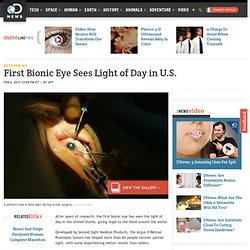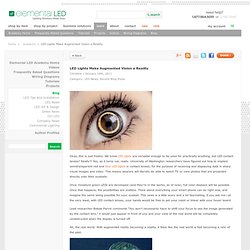

Retinal Implants Restore Partial Sight To Three Blind. A microchip with 1,500 light sensors sits beneath the retina and stimulates neurons which project to the brain's visual cortex.

The blind really are beginning to see again. After receiving retinal implants in a trial, two people in the UK and one in China – all blind – regained part of their vision. And more good news could be on the way as results from other participants comes to light. But the chip is a bright ray of hope for the estimated 1.5 million worldwide that have retinitis pigmentosa, if not for the 285 million visually impaired. All of the trial participants were made blind by retinitis pigmentosa in which the light-sensitive rods and cones of the retina deteriorate. China scores its own first with Tsang Wu Suet Yun. The following is 2010 footage of a Finnish man who had regained partial vision after receiving an implant from Retina. First Bionic Eye Sees Light of Day in U.S. After years of research, the first bionic eye has seen the light of day in the United States, giving hope to the blind around the world.

Developed by Second Sight Medical Products, the Argus II Retinal Prosthesis System has helped more than 60 people recover partial sight, with some experiencing better results than others. Consisting of 60 electrodes implanted in the retina and glasses fitted with a special mini camera, Argus II has already won the approval of European regulators. The US Food and Drug Administration is soon expected to follow suit, making this bionic eye the world's first to become widely available.
PHOTOS: Mechanimals: Animals Fitted With Prosthetics. Eye implant restores vision to blind patients. Frequently Asked Questions. What Is A Retinal Prosthesis?

A retinal prosthesis is a biomedical implant intended to partially restore useful vision to people who have lost their sight due to a degenerative retinal disease such as retinitis pigmentosa (RP) that severely damages the photoreceptors in the eye. How Is Argus® II Designed To Produce Sight? In a healthy eye, the photoreceptors (rods and cones) in the retina convert light into tiny electrochemical impulses that are sent through the optic nerve and into the brain, where they are decoded into images.

If the photoreceptors no longer function correctly—due to conditions such as retinitis pigmentosa—the first step in this process is disrupted, and the visual system cannot transform light into images. The Argus II Retinal Prosthesis System ("Argus II") is designed to bypass the damaged photoreceptors altogether. A miniature video camera housed in the patient’s glasses captures a scene. The video is sent to a small patient-worn computer (i.e., the video processing unit – VPU) where it is processed and transformed into instructions that are sent back to the glasses via a cable. LED Lights Make Augmented Vision a Reality. LED Lights Make Augmented Vision a Reality Okay, this is just freaky.

We know LED lights are versatile enough to be used for practically anything, but LED contact lenses? Really?! Yes, as it turns out, really. University of Washington researchers have figured out how to implant semitransparent red and blue LED lights in contact lenses, for the purpose of receiving and displaying data in sharp visual images and video. Once miniature green LEDs are developed (and they’re in the works, as of now), full color displays will be possible. Lead researcher Babak Parvis comments “You won’t necessarily have to shift your focus to see the image generated by the contact lens,” it would just appear in front of you and your view of the real world will be completely unobstructed when the display is turned off.
Ah, the real world. Robo-Eye to Enter US Market. A retinal prosthesis, already available in Europe, can restore partial sight to people with a genetic disorder that causes blindness.

WIKIMEDIA, SHELOVESGHOSTSAmericans will soon be able to purchase restored vision, with the US Food and Drug Administration set to approve a prosthetic device that compensates for failing photoreceptors. The Argus II Retinal Prosthesis System, developed and made by Second Sight Medical Products, is already approved for use in many European countries, and the FDA will soon give its stamp of approval, according to DiscoveryNews.